Although Louis Zamperini was brutally tortured inside four Japanese POW camps during World War 2, he not only survived, he later forgave his captors.
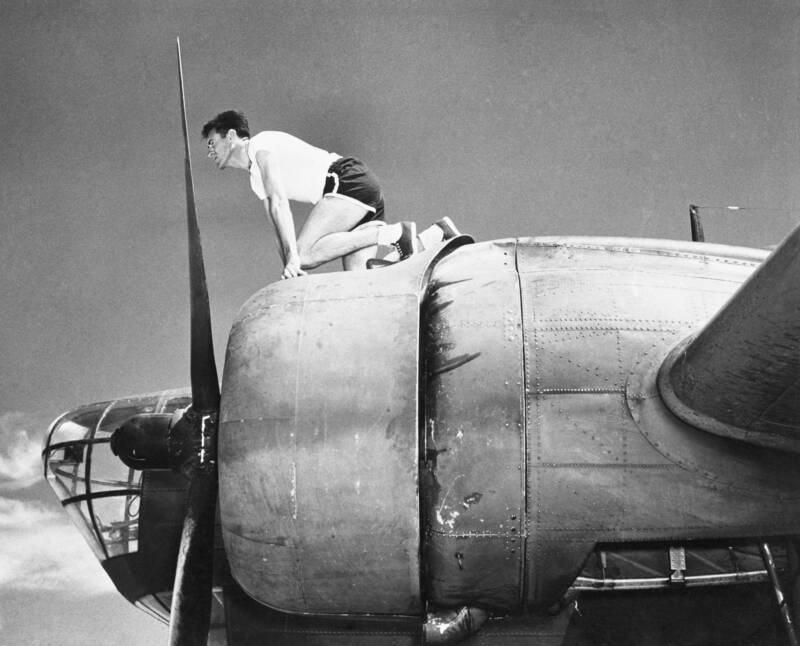
Bettmann/Getty ImagesIn the true story that inspired the 2014 film Unbroken, Louis Zamperini competed in the 1936 Olympics before serving as a pilot in the Pacific during World War II.
When Louis Zamperini was 21 years old, he ran at the 1936 Berlin Olympics and broke records with Adolf Hitler in the audience. By 26, he was an Army Air Corps bombardier serving in World War II, fighting against the Axis Powers. And on May 27, 1943, he crashed into the Pacific Ocean, spending 47 days adrift at sea.
Micarulously, Zamperini survived his time at sea — only to be captured by the Japanese, held as a prisoner of war, and tortured and beaten for an agonizing two years. Zamperini was given “special” treatment by his Japanese captors, too, due to his status as an Olympic athlete.
The U.S. government, meanwhile, had listed Louis Zamperini initially as missing in action when his B-24 bomber sank into the sea — then, officially, as killed in action a year later. He would only be liberated after Japan’s surrender on September 2, 1945. Upon returning home, Zamperini was given a hero’s welcome. He would later become a motivational speaker and author who would live until the age of 97 before passing away in 2014.
From Olympian to Purple Heart recipient, Louis Zamperini’s life was a hero’s journey of the highest order. It made for a bestselling 2010 biography, Unbroken, which the Coen Brothers and Angelina Jolie then adapted into a film in 2014. Despite beating impossible odds with his integrity intact, the stoic veteran never considered himself a hero.
“Oh no,” Louis Zamperini said. “I walk into a VA hospital and see guys in wheelchairs with their legs missing — or two legs missing or an arm missing and they’ve got one Purple Heart. Well, I’m in one piece and I’ve got three Purple Hearts. When a guy gives up part of his body, he’s the hero.”
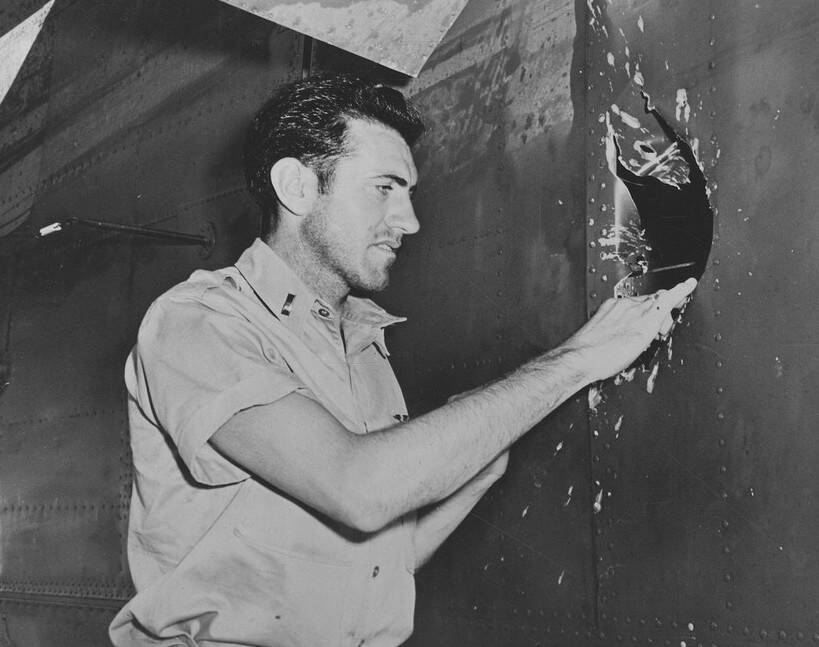
National ArchivesLouis Zamperini examines an impact hole made by a Japanese shell.
This is the heroic story of Louis Zamperini, the man who remained unbroken against unimaginable odds.
Louis Zamperini’s Talent For Running Takes Him To The Olympics
Born on January 26, 1917, in Olean, New York, Louis Zamperini was raised by Catholic first-generation Italians. The family relocated to Torrance, California, when he was two, as dangerous omens foreshadowed incidents to come. He nearly drowned as a young boy, for instance, before nearly burning to death in a house fire.
Zamperini was constantly bullied as an outsider with parents who spoke no English, and joined the track and field team when he was 15 to find refuge. He not only found success, but inspiration from figures like Glenn Cunningham — an athlete who survived near-fatal burns as a child and defied the odds to become a runner.
The bullying also prompted Zamperini’s father to teach him how to box, as a manner of self-defense. Evidently, it worked out for him, though it didn’t help him avoid trouble.
“I was beating the tar out of ever one of them,” Zamperini said in a 2003 interview with the University of Southern California. “But I was so good at it that I started relishing the idea of getting even. I was sort of addicted to it.”

Bettmann/Getty ImagesLouis Zamperini’s high school record for the mile remained unbroken for 20 years.
After Zamperini set the national high school record for the mile by running it in four minutes and 21.2 seconds in 1934, the University of Southern California awarded him a scholarship. He was also, he bragged, “presented with a gold watch by the actor Adolphe Menjou.”
Zamperini, nicknamed the “Tornado of Torrance,” left for New York City and ran 5,000 meters in one of the worst heat waves and record, eager to make the 1936 Berlin Olympics.
Officially qualified, Louis Zamperini soon found himself within feet of Adolf Hitler. He was stationed near the chancellor’s spectator box, where Zamperini thought Hitler “looked funny, like something out of a Laurel and Hardy film.” While he placed eighth in the 5,000-meter race, he ran his last lap in 56 seconds.
“It was quite a sight,” Zamperini remembered. “Though I’d been behind, I sprinted the whole last lap, running it in 56 seconds after three whole miles. The crowd was going nuts.
One member of the crowd, in particular, found Zamperini’s finish impressive and requested a chat. A man by the name of Adolf Hitler.
“Ah,” said Hitler, “you’re the boy with the fast finish.”
Zamperini Sets Athletics Aside To Fight In World War II
While Louis Zamperini had hoped to return to the Olympics in 1940, he enlisted to join the Army Air Corps’ campaign in Europe instead. With the attacks on Pearl Harbor in December 1941, he was soon in active combat — and operating a B-24 Liberator to bomb Japan in the Pacific Theater by April 1943.
“My life as a teenage delinquent had conditioned me for the war,” Zamperini said. But nothing could have prepared him for the awful torture he would experience after his capture.
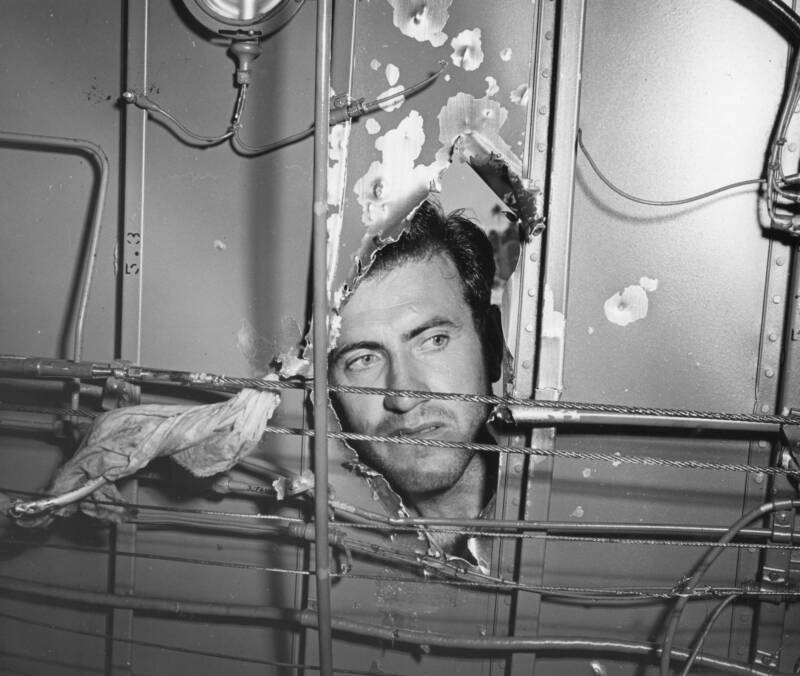
PhotoQuest/Getty ImagesLouis Zamperini inspecting damage from enemy fire on his B-24 bomber in May 1943.
Just a month later, Zamperini was tasked with finding a missing aircraft.
Unfortunately, he was piloting a known semi-defective unit when the rescue mission began. Zamperini and 11 men were in the air when a malfunction sent them crashing into the sea — with only him and two other soldiers surviving the impact.
Co-pilot Russell Phillips, tail gunner Francis McNamara, and Louis Zamperini staved off hunger, heat, thirst, and sharks for weeks.
“It really was a test of survival,” Zamperini recalled. “As we drifted, I remembered Dr. Roberts. He taught us to exercise all sections of the brain. Though the other guys never knew it, ever monring I took inventory to see how we were all doing mentally.”
He would ask them questions about childhood, sing songs, and describe meals he’d like to make and how he would make them. All of this was to help keep the men distracted, motivated, and fighting.
Adrift on a lifeboat, they drank only rainwater and caught the odd fish. And when his parents received a letter of condolences signed by President Roosevelt in June 1943, Zamperini was still alive.
Louis Zamperini’s Horrifying Time As A Prisoner Of War
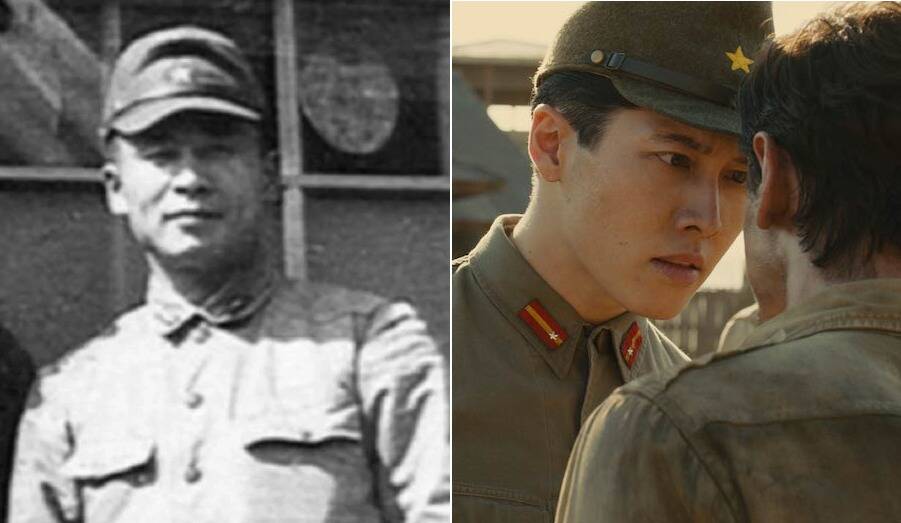
Wikimedia Commons/Universal PicturesThe real Mutsuhiro Watanabe (left) and his portrayal in Unbroken (2014).
McNamara died on the 33rd day at sea, while Louis Zamperini lost 50 pounds before washing ashore the Marshall Islands two weeks later. Zamperini and Phillips were captured by the Japanese and dragged from camp to camp — as subjects of war criminal Sergeant Mutsuhiro Watanabe. The men were beaten daily until 1945.
“I could take the beatings and the physical punishment, but it was the attempt to destroy your dignity, to make you a nonentity that was the hardest thing to bear,” Zamperini recalled.
When officials realized they had an Olympian on their hands, Zemperini’s captors starved and abused him with disturbing focus. He was purposefully separated from Phillips to bolster the psychological distress, while Watanabe regularly boiled over into horrific bouts of violence. Louis Zamperini found strength in his athletic past:
“For one thing, you have to learn self-discipline if you are going to succeed as an athlete. For another thing, you have to have confidence in yourself and believe that no matter what you’re faced with, you can deal with it — that you just can’t give up. And then there’s the aspect of staying in shape. And humor helped a lot.”

Bettmann/Getty ImagesLouis Zamperini (center-right) upon arriving at Hamilton Field, California on Oct. 5, 1945.
Ultimately, Louis Zamperini was likely spared from execution by being an invaluable prisoner the Japanese believed could come in handy later. Fortunately, with the surrender of Japan, the camp was liberated in fall 1945, with the Olympian returning home to the United States — back from the dead.
The “Unbroken” Legacy Of Louis Zamperini
For Louis Zamperini, life as a post-war torture victim was anything but easy. He turned to the bottle to self-medicate his post-traumatic stress, nearly divorcing his wife, Cynthia, in the process. Fortunately, he sobered up — and was married for 54 years before Cynthia died in 2001.
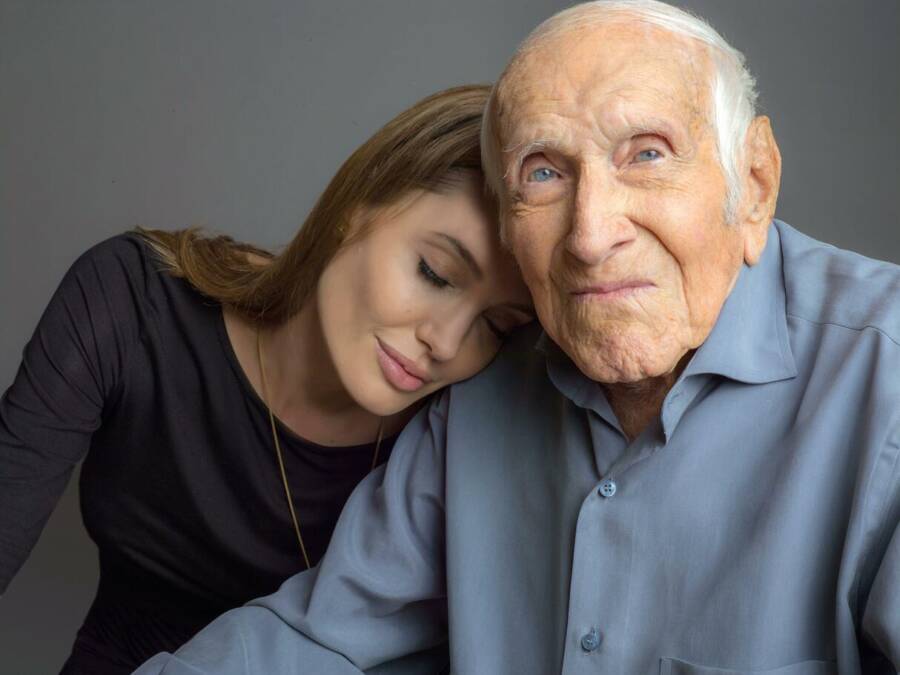
Universal PicturesLouis Zamperini and Angelina Jolie, who directed Unbroken, the film adaptation of his biography.
Spending his later years touring the lecture circuit to inspire people of all ages to overcome their struggles, Zamperini had decades to reflect on his life and garner new insights. It was only later, for instance, that he realized the “skinny guy” he asked take a picture of him and Hitler was Nazi propaganda minister Joseph Göbbels.
Louis Zamperini’s high school record wasn’t bested for 20 years, while he and his wife had raised two loving children. Before he died of pneumonia on July 2, 2014, the veteran confronted his past. During a leg of the Olympic torch relay at the 1998 Winter Games in Japan, Zamperini jogged by the mountains of Naoetsu.
It was here that he had survived years of torture and daily visions of certain death, decades earlier — now returning a triumphant man, who never dared call himself a hero.
After learning about Louis Zamperini and the true story Unbroken, read about Desmond Doss and his heroics in World War II’s Pacific Theater. Then, learn about Calvin Graham, the youngest decorated veteran of World War II.





